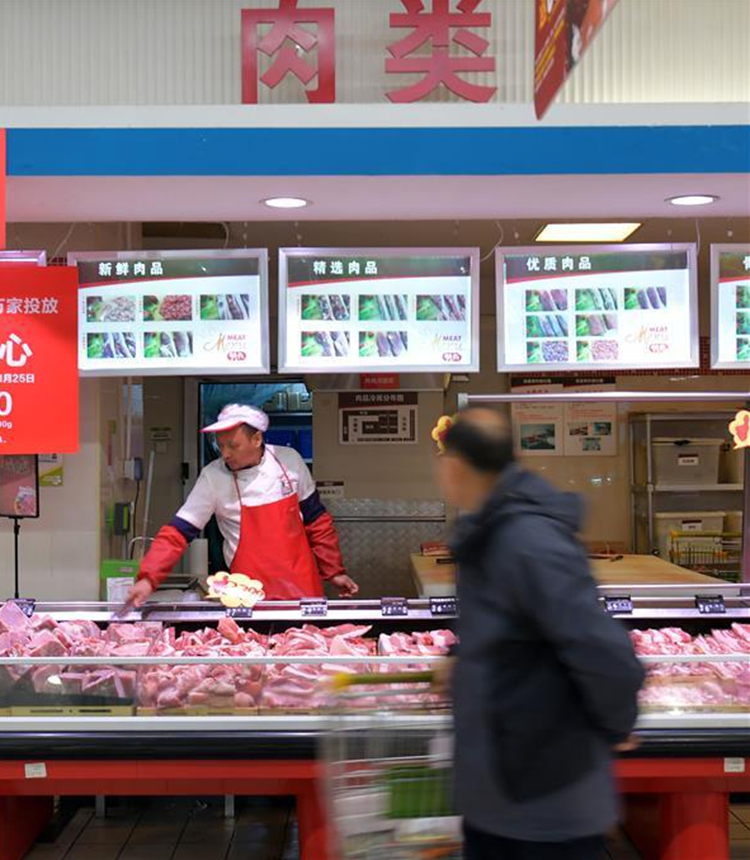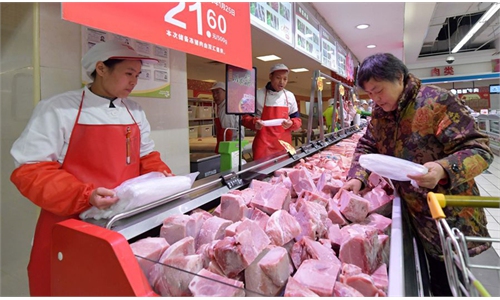SOURCE / INDUSTRIES
China to buy more US pork to fulfill phase one trade deal

Staff members prepare pork at a supermarket in Nanchang, east China's Jiangxi Province, Dec. 22, 2019. Local authorities has released on Sunday more frozen pork reserves to ensure market supply for the upcoming holidays and to keep the pork price stable. The price is 43.2 yuan (about 6.2 U.S. dollars) per kg. (Xinhua/Peng Zhaozhi)
US' frozen pork inventories dropped in June, as exports to China surged. An analyst said that China is implementing the phase one trade deal, buying $32 billion worth of US agricultural products over two years despite a global shrinkage of trade caused by COVID-19.
US frozen pork stocks were down 25 percent year-on-year by June, the US Department of Agriculture (USDA) said Wednesday, after several US meat plants reported coronavirus outbreaks among their workers.
Seaborne exports to China jumped 135 percent year-on-year in June, per data from Panjiva, a supply chain research unit of S&P Global.
"US pork clearance requests and inquiries have increased from April," Ailian, a logistics and clearance agency based in Shanghai, told the Global Times Thursday. The company declined to disclose specific data.
It said that the customs clearance time for frozen meat is almost the same as it was before, because China's meat import quarantine measures have always been very strict and COVID19 tests do not take a long time.
According to the latest data from the US Meat Export Federation, China imported 333,445 tons of pork from the US from January to May in 2020, up 531.4 percent from last year. China accounted for 29.4 percent of all US pork exports.
Chinese pork production giant Shuanghui Group said during an online performance presentation earlier that it will expand imports of US pork this year.
China currently imports meat from 41 countries and regions, and over 2,000 overseas meat production enterprises are qualified to export to China, according to customs statistics.
"Though it has many sources of pork imports, China continues to purchase US pork under the Phase One trade agreement. Despite the downturn in global trade, China is likely to buy more US meat products," Wang Gangyi, a professor at Northeast Agricultural University, told the Global Times Thursday.
An agriculture analyst surnamed Ma said that in addition to pork, China is buying other US agricultural products to implement the trade deal.
"It is more economic for China to import US agricultural products than to buy US Treasuries, as the yields of which continue to fall. China holds large amounts of US dollars. Additionally, most farming land in China has been planted with staple grains, including rice and wheat, to ensure food security," Ma told the Global Times Thursday.
According to data from the National Bureau of Statistics, 84.3 percent of China's planting area, 116 million hectares, was sown with cereal crops in 2019.
It is a rational choice to import agricultural products such as soybeans and corn to increase market grain supply, Ma noted.
According to the USDA, the US' corn harvest area is expected to increase 3 percent from 2019, and the country's soybean planting area is expected to expand 11 percent.


